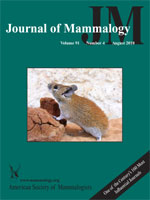Direct observation of mating behavior in the Japanese giant flying squirrel (Petaurista leucogenys) in a temperate mixed forest, central Japan, was carried out for 976 nights over an 8-year period (1983–1991). A total of 153 mating dates was observed involving 35 different adult females. Two mating seasons were apparent, 1 in early summer from mid-May to mid-June (range 36 days) followed by 1 in winter from mid-November to late January (74 days). Each female came into estrus twice a year and mated on 1 night in each mating season. Mothers with nursing young came into estrus relatively later within a mating season. No difference was observed in the proportion of mothers mating in each season, and the mild winter conditions enabled reproductive investment by females during winter. Each reproductive bout (from conception to weaning) required 4–6 months, and mature females were engaged in reproduction all year. The biannual reproductive strategy is thought to be compensated for by a small litter (1 or 2 young). The initiation of feeding by the recently weaned offspring coincided with the months of highest food availability in spring and autumn.
How to translate text using browser tools
16 August 2010
Biannual reproductive cycles in the Japanese giant flying squirrel (Petaurista leucogenys)
Takeo Kawamichi
ACCESS THE FULL ARTICLE

Journal of Mammalogy
Vol. 91 • No. 4
August 2010
Vol. 91 • No. 4
August 2010
arboreal sciurids
copulatory plug
estrus
food availability
giant flying squirrel
Petaurista leucogenys
Petaurista philippensis




